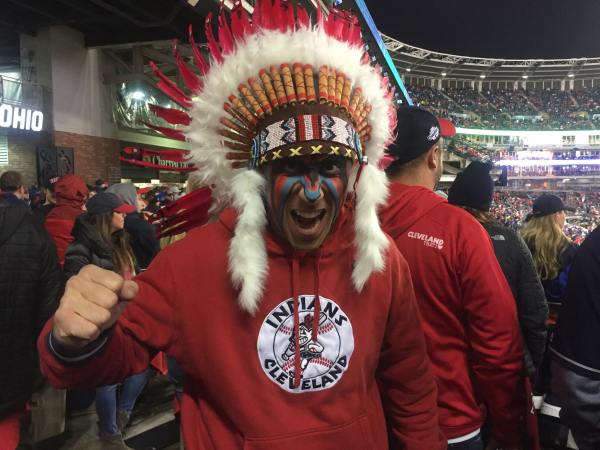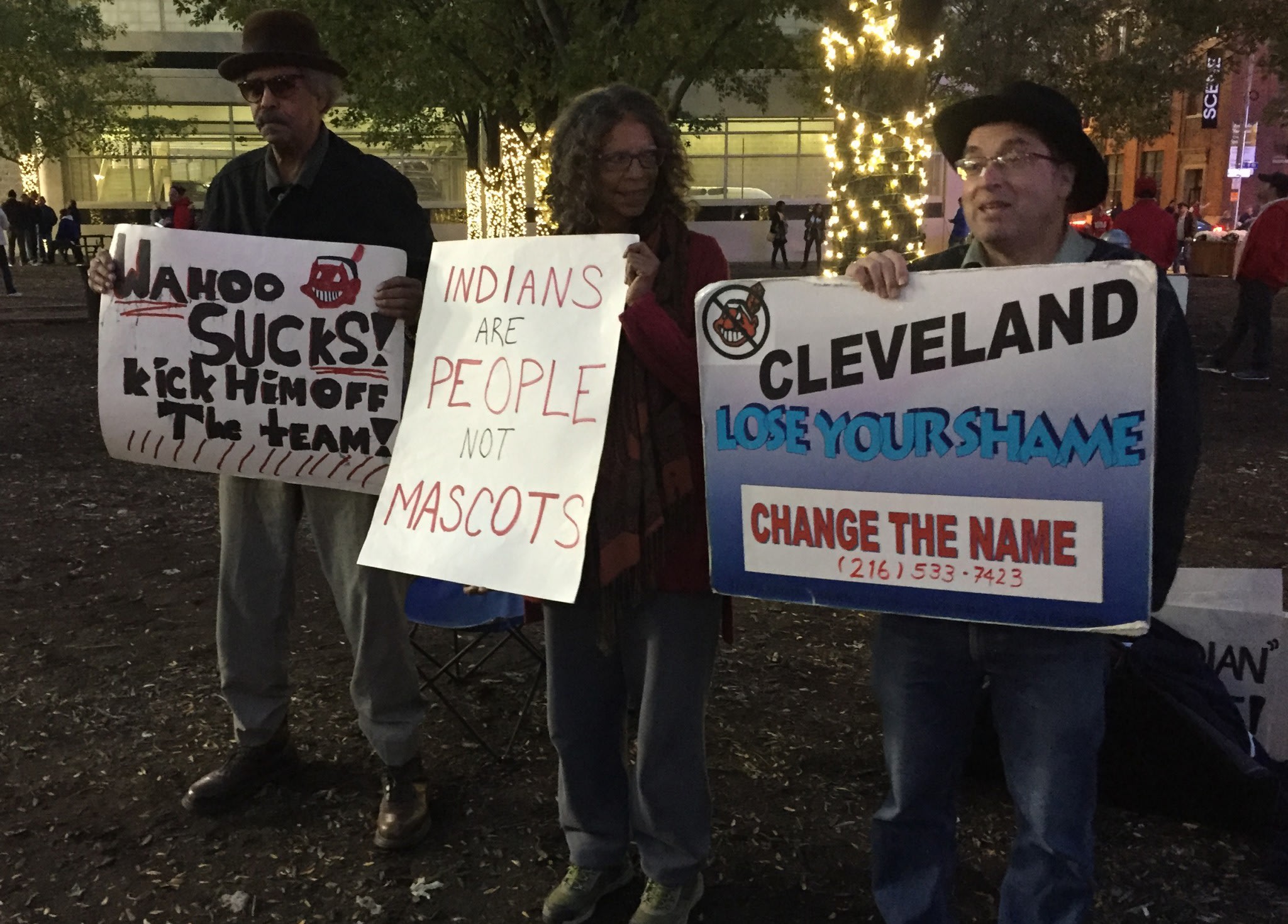As fans filled into Game 1 of the World Series, the type of baseball event this city hasn’t seen in a couple decades, a small group of activists gathered in a courtyard across from the stadium.
There were half a dozen of them and they held signs that read: “People Not Mascots,” “Stop Teaching Your Children Racism” and “Cleveland, Lose Your Shame, Change the Name.”
In the middle was Sundance, the one-named activist who oversees the Cleveland American Indian Movement, the group that has been protesting Cleveland’s Chief Wahoo logo and the Indians’ team name on every Opening Day for the past 46 years.
“We need the support of people across this country and worldwide,” Sundance said. “The baseball team and Major League Baseball just aren’t responsive to us. We are faced with an intransigent opponent, so we have to persevere.”
The Indians being in the World Series inspired him to organize his first protest of the postseason, to get his message in front of a bigger, potentially international audience.
“This is our moment,” he said.
Across the way, walking toward the stadium gates was Jeff Raycher, a lifelong Indians fan who had picked World Series Game 1 to dress up for an Indians game like never before. He wore a full headdress. When he got inside the stadium, he painted his face black, red and blue — more like the Ultimate Warrior than the fans we often see come to the stadium in full redface, personifying the Indians’ Chief Wahoo logo.
 |
Jeff Raycher in his headdress and face paint at World Series Game 1. (Yahoo Sports)
|
Raycher saw the protestors as he walked in and didn’t go near them.
“I intentionally avoided them,” said Raycher, a 37-year-old from Cleveland. “I didn’t want to cause any unrest. I’m not here to antagonize. I didn’t want to offend anybody, so I steered clear.”
These are the two sides of a debate that runs deep, a debate that’s been reignited this postseason. Everything gets amplified in the World Series — the importance of a team’s seventh-inning relief pitcher, a hitter’s slump and the divided opinions about a team’s mascot.
In the American League Championship Series, when the Indians faced the Blue Jays, a Native American activist in Canada tried to get an injunction stopping the Indians from playing as the Indians in Toronto. It didn’t work. In the World Series, Chief Wahoo — the red-faced caricature that adorns Indians caps and jersey sleeves — has been inspiring a lot more questions than he did in August.
On Wednesday, during the ceremony that awarded the Hank Aaron Award to Kris Bryant and David Ortiz, a reporter asked commissioner Rob Manfred his thoughts on Chief Wahoo. The Wahoo debate even seeped into a normal trophy presentation.
“I know that that particular logo is offensive to some people,” Manfred said. “And all of us at Major League Baseball understand why. Logos are, however, primarily a local matter. The local club makes decisions about its logos. Fans get attached to logos. They become part of a team’s history. So it’s not as easy as coming to the conclusion and realizing that the logo is offensive to some segment.
“I’ve talked to [Indians owner Larry] Dolan about this issue. We’ve agreed away from the World Series at an appropriate time we will have a conversation about this. I want to understand fully what his view is, and we’ll go from there. At this point in this context, I’m just not prepared to say more.”
But other people are, on both sides of the debate. Social media and comment sections get ugly anytime the mascot debate comes up. Same thing with the NFL’s Washington Redskins, who face similar scrutiny for their name. However, a recent Washington Post poll said nine of 10 Native Americans weren’t bothered by the Redskins name. The Indians have distanced themselves from Wahoo to some degree in the past, making the block “C” their primary logo. But they’ve stopped short of getting rid of him altogether. Wahoo still appears on caps, especially this postseason.
The debate, especially as far as the Indians are concerned, is a complex one. Is the Indians name offensive? Is the Chief Wahoo logo? Both? One but not the other? But what’s a fan to do? Their favorite team is in the World Series. Many of them — like Raycher — are at the pinnacle of their fandom.
“We’re the Indians, so I’m supporting my team,” Raycher said. “It’s fan fare. We go crazy for our Cleveland sports. It’s certainly not meant to be antagonistic or anything like that. As long as we’re the Indians, fans are going to do what fans do, which is dress crazy and wear the logo.”
Raycher said he had never dressed up this much for a game before. He come to games with streaks of war paint or put feathers in his cap. But the World Series inspired him to go further, knowing full well about the recent debate around Chief Wahoo and the Indians name.
“I don’t take offense to those that take offense to it,” Raycher said. “At the same time, I don’t think that people that wear the gear and dress up are doing it to be offensive. Those of us who are Tribe historians know that the reason they named the team was to be an honorary thing, not to be a racist thing or an incendiary thing.”
Sundance and Cleveland American Indian Movement wouldn’t agree with that. Sundance, who is part of the Muscogee tribe, says he watched Tuesday night as other Indians fans walked by in redface, feathers or headdresses. And he’s seen them at the stadium at other games too.
“How do I feel? It doesn’t surprise me because I understand the environment that I live in,” Sundance says. “In this country, it is still OK to discriminate in public against natives and against Asians — apparently we all look alike. How do I feel? I feel sorry for them. Because as with many of the fans, many of them think they’re actually honoring us. But they don’t want to hear from us. They’re honoring us as long as we’re silent.”
 |
Protestors outside of World Series Game 1 in Cleveland. (Yahoo Sports)
|
Despite the strong feelings on each sides, there were meet-in-the-middle moments during the protest. One Indians fan sat nearby smoking a cigarette, wearing a Chief Wahoo cap. He looked at the group of protestors — six people at the time — and eventually walked up to them.
He didn’t want to argue. He wanted to ask questions. What if, he asked, it was a more realistic drawing? Would that be OK? What if the Indians just picked one tribe and tried to honor them? Would that be OK?
Another group of Cubs fans stopped as they were walking by and said, “We agree with you. What can we do to help?”
Other people walked by and flipped off or yelled at the protestors. But not as many as on Opening Day, which Sundance says it the most contentious day of the year. Barring any major changes when Manfred meets with Indians ownership, this will all happen again at the start of next season.
Sundance and his group will be out there with their signs. Fans like Raycher will be there with their face paint and feathers. And the debate will continue, same as every year.
“I’m not here,” Raycher said, “to make a statement. But I have no problem with them making a statement. They have every right to stand out here and protest and I’m OK with that.”
“When they change the name and the logo,” Sundance said, “I’ll take my kid to a game. Probably at this stadium. They’ll finally get my money.”
No comments:
Post a Comment